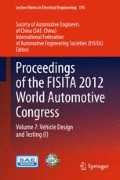Abstract
In ADAMS/Car, the simulation platform—six-post test-rig which can identify dual-tire model was developed specialty for testing leaf spring balanced suspension of heavy truck. Based on this, the virtual prototype model of the drive form of 6 × 4 heavy truck was built, and simulation containing four excitation modes were conducted by assembling the virtual prototype model of heavy truck with leaf spring balance suspension to the special six-post test-rig. Design bugs of the leaf spring balance suspension were fund out and approach improving on these problems was proposed by analyzing computed results.
F2012-E03-002
Access this chapter
Tax calculation will be finalised at checkout
Purchases are for personal use only
References
Li B (2007) Research on design method of double front axle truck balance suspension [D]. Jilin University, Changchun (In Chinese)
Wang S (2004) The suspension kinematics and elastic kinematics modeling, analysis and evaluation [D]. Jilin University, Changchun (In Chinese)
Wang Q, Fang X, Ma H (2001) Based on the virtual prototype technology in the design and analysis of automobile leaf spring [J]. Chin J Mech Eng (12):63–66 [In Chinese]
Zhao L, Wang Y, Xu D (2003) Multiple axle equilibrium suspension and Tts performance analysis of new structure form. Spec purp veh (5):10–12 [In Chinese]
Zhang Y, chen L (2005) The analysis of dynamics of mechanical systems and ADAMS applications [M]. Tsinghua University press, Beijing [In Chinese]
Makita M (1999) An application of suspension kinematics for intermediate level vehicle handling simulation. JSAE Rev 20(4):471–477
MSC Software (2003) ADAMS/Car training guide. Release 2003
MSC Software (2007) ADAMS 2007R2/help, ADAMS/Car
Author information
Authors and Affiliations
Corresponding author
Editor information
Editors and Affiliations
Rights and permissions
Copyright information
© 2013 Springer-Verlag Berlin Heidelberg
About this paper
Cite this paper
Tang, X., Liu, K. (2013). Simulation of Leaf Spring Balanced Suspension Based on Virtual Test-Rig. In: Proceedings of the FISITA 2012 World Automotive Congress. Lecture Notes in Electrical Engineering, vol 195. Springer, Berlin, Heidelberg. https://doi.org/10.1007/978-3-642-33835-9_13
Download citation
DOI: https://doi.org/10.1007/978-3-642-33835-9_13
Published:
Publisher Name: Springer, Berlin, Heidelberg
Print ISBN: 978-3-642-33834-2
Online ISBN: 978-3-642-33835-9
eBook Packages: EngineeringEngineering (R0)

